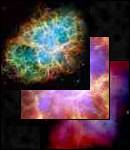Images - 3
Crab Nebula & its Pulsar
NGC 5679 (Arp 274)
NGC 5679 comprises three galaxies that appear to overlap each other, but are probably at slightly different distances from us. The spiral shapes of the two larger galaxies appear mostly intact, and if they were very close, they would have disrupted each other. The third galaxy, on the left of the image, is much smaller. The blue patches, seen mainly in the left and right galaxies, represent areas of new star formation. The yellow areas, mainly in the center of each galaxy, shows older yellow stars. The system is approximately 123 Mpc away (400 million light-years). The two very bright stars just above the center on the right are in our Milky Way galaxy, and much, much closer to us.
This unusual galaxy was discovered in 1950 by astronomer Art Hoag, and is located approximately 183 Mpc (about 600 million light-years) away. It is an almost perfect ring of hot, blue stars surrounding the yellow nucleus of an unusual galaxy known as Hoag's Object. The galaxy is about 120,000 light-years wide across the outer limits of the ring, slightly larger than our Milky Way Galaxy. The blue ring, which is dominated by clusters of young, massive stars, contrasts sharply with the yellow nucleus of mostly older stars. What appears to be a "gap" separating the two stellar populations may actually contain some star clusters that are almost too faint to see. Curiously, an object that bears an uncanny resemblance to Hoag's Object can be seen in the gap at the one o'clock position. The object is probably another ring galaxy in the background.
Hoags Object (Ring Galaxy)
The Crab Nebula is the remnant of a supernova that occured in 1054, which was recorded by Chinese and Arab astronomers at the time. It is about 6,500 light-years away, and, after less than 1,000 years, is already about 11 ly across as it is expanding at about 1,500 km (nearly 1,000 miles) per second. The Pulsar, or rotating Neutron star, which is the driving force behind the nebula, is about 25 to 30 km (~ 15 to 19 miles) in diameter, and pulses every 33 milliseconds. While the pulses are incredibly precisely timed, like all pulsars, the Crab pulsar is slowing down in a very predictable way. In the Crab's case, this is by 38 nanoseconds per day, and is due to the large amounts of energy being carried away in the pulsar wind which is what drives the gas and dust out. The three images show the whole nebula, the central portion highlighting the neutron star, and a combined optical (hubble) & X-ray (chandra) image.
Astronomy & Cosmology
-
Hubble Space Telescope
Ring-shaped galaxies can form in several different ways. One possible scenario is through a collision with another galaxy. Sometimes the second galaxy speeds through the first, leaving a "splash" of star formation. But in Hoag's Object there is no sign of the second galaxy, which leads to the suspicion that the blue ring of stars may be the shredded remains of a galaxy that passed nearby. Some astronomers estimate that the encounter occurred about 2 to 3 billion years ago.
Hubble took this image on July 9, 2001. Credit: NASA and The Hubble Heritage Team (STScI/AURA), Ray A. Lucas (STScI/AURA)
Hubble took this image on July 9, 2001. Credit: NASA and The Hubble Heritage Team (STScI/AURA), Ray A. Lucas (STScI/AURA)




